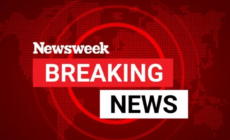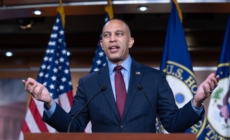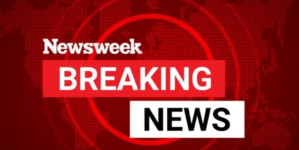-
Patreon’s C.E.O.: My Vision for a Better Internet - 14 mins ago
-
House Bunny Gets Sibling, Hysterics at Their Response: ‘Double Stomping’ - 30 mins ago
-
Russia Strikes Ukraine as Zelensky Aims to Revive Peace Talks - 58 mins ago
-
Democrats Open Up Biggest Polling Lead Over Republicans in Eight Years - about 1 hour ago
-
US Flexes Bomber Power on China’s Doorstep - 2 hours ago
-
The White House Gold Rush Is On - 2 hours ago
-
Video Shows Opening of Tallest Hotel in the World - 2 hours ago
-
Europe’s Chip Dreams Confront Business Realities - 2 hours ago
-
Will Donald Trump veto Epstein files bill? Mike Johnson raises possibility - 3 hours ago
-
Trump Administration Gives Three Mile Island Nuclear Project $1 Billion Loan - 3 hours ago
US Flexes Bomber Power on China’s Doorstep
The United States demonstrated the combat power of its bomber force deployed in Japan as diplomatic tensions between the American treaty ally and China deepen.
The Chinese Foreign Ministry did not immediately respond to a request for comment.
Why It Matters
The U.S. Air Force regularly rotates its bombers—the B-1B Lancer, the B-2 Spirit and the B-52H Stratofortress—in the Indo-Pacific for Bomber Task Force missions. Four B-1B bombers have been operating from Misawa Air Base in Japan since mid-October.
The bomber mission is part of the Pentagon’s efforts to bolster U.S. military presence near China—including F-35 stealth fighter jets and nuclear-powered submarines—to deter aggression from China toward Taiwan, a self-ruled island claimed by Beijing.
Japanese Prime Minister Sanae Takaichi recently said Japan could deploy its military should China move against Taiwan and the U.S. come to the island’s aid. The remarks drew a fierce response from Beijing, which accused Tokyo of “playing with fire.”
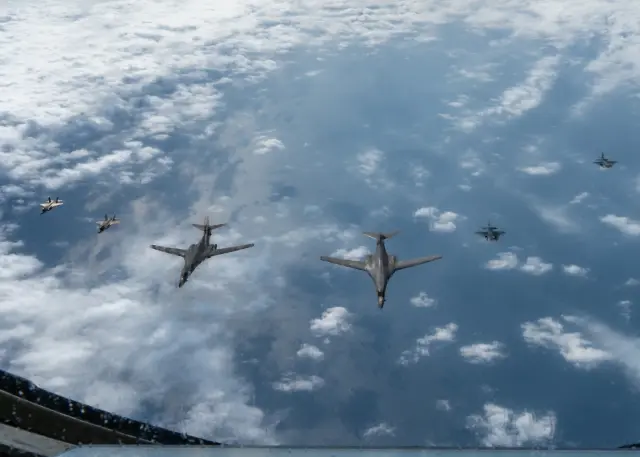
What To Know
On Monday, in response to an “increasingly severe security environment,” American and Japanese forces conducted a bilateral exercise over the East China Sea, west of Kyushu Island, and the Pacific Ocean, east of Okinawa Island, the Japan Joint Staff said.
The tactical drill involved a large number of aircraft from both forces, including two B-1B bombers and 12 F-35A jets from the U.S., as well as two F-2 and four F-15 jets from Japan. Photos show B-1B bombers flying in formation with F-35A and F-2 jets.
“The U.S. remains committed to peace and prosperity throughout the Indo-Pacific alongside our Japanese allies, together acting as the cornerstone of regional peace and security and presenting an ironclad defense of Japan,” one photo caption said.
Meanwhile, the B-1B bomber conducted its first-ever munitions load operation in mainland Japan, with GBU-54 bombs loaded onto a bomber at Misawa Air Base on November 10, according to photos released on Monday by the U.S. Pacific Air Forces.
According to an official fact sheet, the B-1B bomber has the largest conventional weapons payload in the U.S. Air Force, capable of carrying up to 75,000 pounds of bombs and missiles “against any adversary, anywhere in the world, at any time.”
The 500-pound GBU-54 bomb is equipped with laser guidance to accurately strike moving targets, a photo caption said. The munitions load operation underscored what the U.S. Pacific Air Forces called “force integration” and enhanced regional readiness.
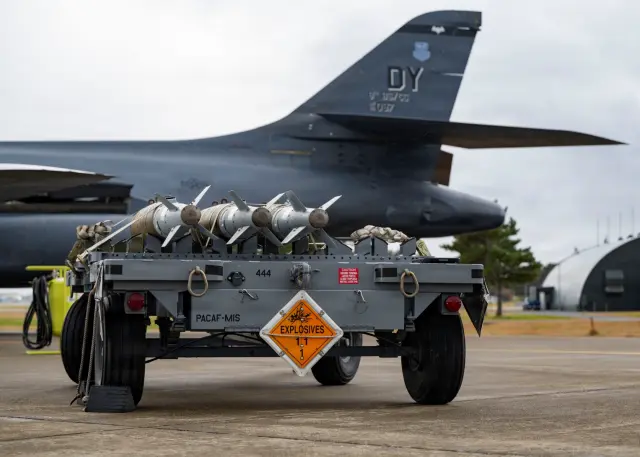
What People Are Saying
The U.S. Pacific Air Forces said on Tuesday: “Training together like this reinforces the trust, teamwork, and shared commitment between Japan and the United States—helping us stay prepared, strengthen deterrence, and support a free and open Indo-Pacific. This collaboration showcases the readiness of both forces and the enduring strength of the Japan-U.S. Alliance.”
The Japan Joint Staff said on Tuesday: “This bilateral exercise reaffirms the strong will between Japan and U.S. not to tolerate unilateral changes to the status quo by force. This also demonstrates the readiness of [Japan Self-Defense Forces] and U.S. Armed Forces, and further strengthens the deterrence and response capabilities of the Japan-U.S. Alliance.”
What Happens Next
The U.S. is expected to bolster its military presence in Japan, which hosts about 60,000 American troops in exchange for Washington’s security guarantees. It remains unclear where U.S. bombers will be deployed next in the western Pacific.
Source link




